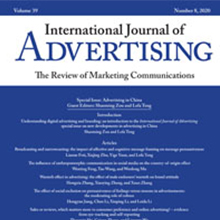본문
Activating persuasion knowledge in native advertising: the influence of cognitive load and disclosure language

By Prof. Eun-Sil (Eunice) Kim (eunicekim@ewha.ac.kr)
Department of Psychology
Professor Eun-Sil (Eunice) Kim’s recent publication, "Activating persuasion knowledge in native advertising: the influence of cognitive load and disclosure language”, incorporated the construct of cognitive load to enhance our current understanding of the effectiveness of advertising operating at an implicit level; in the current context, native ads.
Native advertising, advertising in a format and style identical to publishers’ original content, has received much attention recently, becoming central to both academia and advertising industries. Native advertising, to a certain extent, can be considered as a version of an advertorial sponsored by organizations for strategic purposes. It functions similarly as soft-selling techniques, such as product placement, sponsorship, sponsored links, sponsored posts, e-sponsorship, etc. However, using a longer format that resembles an editorial style allows native advertising to create richer and deeper meanings for sponsors than traditional sponsorship.
As native advertising grows in popularity, increased research has been conducted to understand how consumers respond to this advertising format. Empirical and anecdotal evidence suggests mixed findings on the effectiveness of native advertising. On the one hand, the less intrusive nature of native advertising leads to a more positive attitude compared to traditional banner ads (Tutaj and van Reijmersdal 2012). On the other hand, consumers may negatively react to native advertising when they perceive its covert format as manipulative (Wojdynski and Evans 2016).
In fact, many studies demonstrated that the effectiveness of native advertising may be contingent upon consumers not recognizing its persuasive intent (e.g. Tutaj and van Reijmersdal 2012). Therefore, one major area of research on native advertising emphasizes how native ads are perceived and processed by consumers. In particular, several studies examined various uses of disclosure information (e.g. the size, placement and language), suggesting variances in disclosure influence the recognition and perception of native advertising that results in different brand and publisher evaluations (e.g. Wojdynski and Evans 2016). This line of research mainly adopts the persuasion knowledge model (PKM) as the theoretical foundation. PKM posits that consumer responses to persuasive messages are moderated by how much knowledge they hold regarding persuasion attempts (Friestad and Wright 1994). A major conclusion of native advertising research is that certain ways of displaying disclosure labels, like high visual prominence, explicit language, and bottom positioning, lead to strong ad recognition which results in negative evaluations (e.g. Wojdynski and Evans 2016).
However, existing investigations on native advertising may not provide a holistic picture of the impact of persuasion knowledge by merely focusing on how disclosure information is presented. Previous research has demonstrated that the activation of persuasion knowledge actually depends on one’s cognitive resources to a great extent (e.g. Evans and Hoy 2016) especially in the circumstances in which he/she perceives high persuasive intent (Wentzel, Tomczak, and Herrmann 2010). In other words, when individuals have sufficient cognitive resources, they are very likely to activate and access persuasion knowledge, whereas persuasion knowledge may not be fully activated when individuals experience high cognitive load (Campbell and Kirmani 2000).
Therefore, this research examined whether cognitive load influences the effectiveness of ads operating at an implicit level; in the current context, native ads. Based on the theory of limited cognitive capacity (Lang 2000) and information processing literature, this research sought to further understand the role of persuasion knowledge in native advertising by taking cognitive load into account.
With two experimental studies, this research examined the interplay between cognitive load and disclosure language on the activation of persuasion knowledge and perceived manipulativeness of native ads. Two studies consistently demonstrated that different levels of cognitive load influence how people process and perceive the native ads with varied disclosure language (i.e. explicit vs. implicit). Specifically, this study identified that cognitive load interacted with disclosure language to influence conceptual persuasion knowledge and perceived manipulativeness. Results of the Study 1 suggested that when people had available more cognitive resources (i.e. the low cognitive load condition), the effects of disclosure language became more salient as an explicit label triggered stronger conceptual persuasion knowledge and perceived manipulativeness. In a similar vein, findings of the Study 2 suggested that an explicit disclosure language outweighed an implicit one in detecting the manipulative intent of the native article; however, such effect was significant for people with limited cognitive resources (i.e. the high cognitive load condition).
This research augmented existing research on persuasion knowledge in a native advertising context and introduces disclosure language as an important boundary condition for the activation of persuasion knowledge. Moreover, cognitive load is an important factor that can help explain consumers’ differential response to native advertising disclosure information. Therefore, it is crucial to include cognitive load in theoretical models on the effects of native advertising disclosure.

* Related Article
Taylor Jing Wen, Eunice Kim, Linwan Wu &Naa Amponsah Dodoo (2020) Activating persuasion knowledge in native advertising: the influence of cognitive load and disclosure language, International Journal of Advertising, 39:1, 74-93
* References
Campbell, M.C. and A. Kirmani. 2000. Consumers' use of persuasion knowledge: The effects of accessibility and cognitive capacity on perceptions of an influence agent. Journal of consumer research 27: 69–83
Friestad, M. and P. Wright. 1994. The persuasion knowledge model: How people cope with persuasion attempts. Journal of Consumer Research 21: 1–31.
Lang, A. 2000. The limited capacity model of mediated message processing. Journal of Communication 50: 46–70.
Tutaj, K. and E.A. van Reijmersdal. 2012. Effects of online advertising format and persuasion knowledge on audience reactions. Journal of Marketing Communications 18: 5–18.
Wentzel, D., T. Tomczak, and A. Herrmann. 2010. The moderating effect of manipulative intent and cognitive resources on the evaluation of narrative ads. Psychology &Marketing 27: 510–530.
Wojdynski, B.W. and N.J. Evans. 2016. Going native: Effects of disclosure position and language on the recognition and evaluation of online native advertising . Journal of Advertising 45: 157–68
